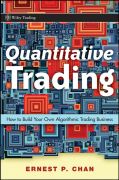
Quantitative trading: how to build your own algorithmic trading business
Chan, Ernie
INDICE: Preface. Acknowledgments. Chapter 1. The Whats, Whos, and Whys of Quantitative Trading. Who Can Become A Quantitative Trader? The Business Case for Quantitative Trading. Scalability. Demand on Time. The Un-necessity of Marketing. The Way Forward. Chapter 2. Fishing for Ideas. Where can we find good strategies? How to Identify a Strategy That Suits You. Your Working Hours. YourProgramming Skills. Your Trading Capital. Your Goal. A Taste for Plausible Strategies and Their Pitfalls. How Does It Compare with a Benchmark and How Consistent Are Its Returns? How Deep and Long is the Drawdown? How Will Transaction Costs Affect the Strategy? Does the Data Suffer from Survivorship Bias? How Did the Performance of the Strategy Change Over the Years? Does the Strategy Suffer from Data-Snooping Bias? Does the Strategy Fly under the Radar of Institutional Money Managers? Summary. Chapter 3. Backtesting. Common Backtesting Platforms. Excel. MATLAB. TradeStation. High-End Backtesting Platforms. Finding and Using Historical Databases. Are the Data Split- and Dividend-Adjusted? Arethe Data Survivorship-Bias-Free? Does Your Strategy Use High and Low Data? Performance Measurement. Common Backtesting Pitfalls to Avoid. Look-Ahead Bias. Data-Snooping Bias. Sample Size. Out-of-sample testing. Sensitivity Analysis. Transaction Costs. Strategy Refinement. Summary. Chapter 4. Setting up Your Business. Business Structure: Retail or Proprietary? Choosing a Brokerage or Proprietary Trading Firm. Physical Infrastructure. Summary. Chapter 5. Execution Systems. What an Automated Trading System Can Do for You. Building a Semi-automated Trading System. Building a Fully Automated Trading System. Minimizing Transaction Costs. Testing Your System by Paper Trading. Why Does Actual Performance Diverge from Expectations? Summary. Chapter 6. Money and Risk Management.Optimal Capital Allocation and Leverage. Risk Management. Psychological Preparedness. Summary. Appendix. A Simple Derivation of Kelly Formula when Returns Distribution is Gaussian. Chapter 7. Special Topics in Quantitative Trading. Mean-Reverting Versus Momentum Strategies. Regime Switching. Stationarity and Cointegration. Factor Models. What Is Your Exit Strategy? Seasonal Trading Strategies. High Frequency Trading Strategies. Is it Better to Have a High-Leverage versus a High-Beta Portfolio? Summary. Chapter 8. Conclusion. Can Independent Traders Succeed? Next Steps. Appendix A. A Quick Survey of MATLAB. Bibliography. About the Author. Index.
- ISBN: 978-0-470-28488-9
- Editorial: John Wiley & Sons
- Encuadernacion: Cartoné
- Páginas: 208
- Fecha Publicación: 26/11/2008
- Nº Volúmenes: 1
- Idioma: Inglés
